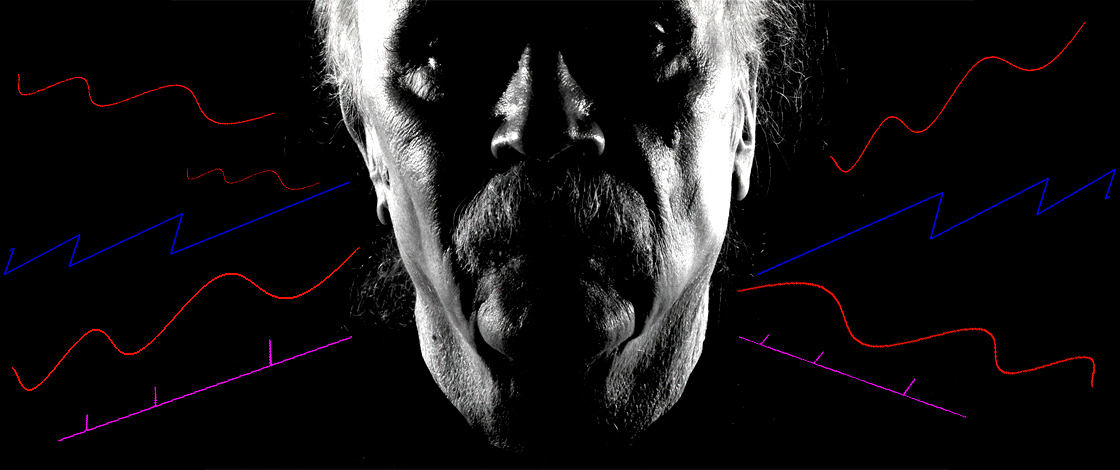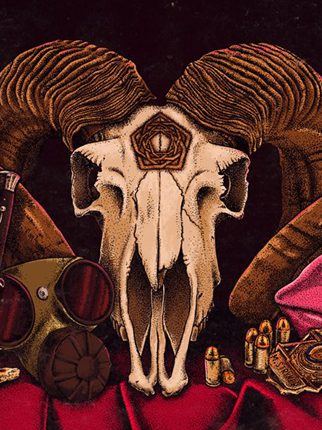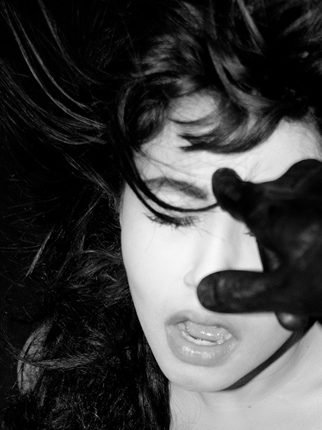Synthwave of Horror Part 3: John Carpenter

Welcome to the final chapter in our Synthwave of Horror series. After talking with some of the most horrific electronic musicians about their craft, the man whom they look to as their dark deity has finally cursed us with his presence: John Carpenter, the writer, director and musician behind some of the greatest horror movies of the ‘80s and beyond, including classics like The Thing and Halloween.
“I’ve always liked electronic music… The great thing is that now the music can speak for itself; it’s not just a score.”
I talked with John at my normal interviewing haunt, which now was more appropriate than ever: Escape From New York Pizza in San Francisco. He told me about everything from his classic films and electronic scores to the movies that inspired him and the artists he inspired through his work. On top of that, we touched on his first upcoming live show and his recently released album, Lost Themes.
This was a big year for you, John. You released your first album and announced your first-ever live show in Iceland. How did that all come about? And why now?
You mean Lost Themes? Well, it came out in March, I believe, and it started out as an improvisational project with my son, my godson, and myself. But eventually it grew into an album. It’s basically the theme music for the movies that are in your head. And why do it now? Why not, man!
Fair point. Do you guys jam a lot?
Oh yeah, we jam all of the time.
It must be great to do that with them. So, what got you started making electronic music in the first place? Obviously, it became a theme in your films… but why synths?
I’ve always liked electronic music, because in the old days you could sound big with just a keyboard. Double-tracking, triple-tracking and multi-tracking yourself made a soundtrack become huge. So, that’s how it started, and as the technology grew, I grew into the music. The great thing is that now the music can speak for itself; it’s not just a score.
“Unfortunately, people don’t care about creative control anymore. They just don’t give a shit—they just want the job, and that’s it.”
Did you grow up in a musical household?
Yeah, actually, my father was a music teacher. He has a PhD from Eastman School of Music, and he taught at Western Kentucky University. So as a kid, I played violin, piano, guitar, bass guitar, and what have you.

Is that connection part of the reason you wanted to make your own scores?
It’s one of the reasons. But before that, I fell in love with movies. When I was a little kid in my formative years, it was the golden age of science fiction, and those movies really inspired me. So, when it came time to decide what I was going to do with the rest of my life, I ended up going to USC to study film; and while I was there, I’d score my own movies and the movies that my classmates would make. It all kind of was a parallel track, movies and music.
When you were at USC, you must have met some amazing directors. Who were some of your heroes?
USC has a great connection with Hollywood, so we had a lot of classic directors come talk to us, like Orson Welles, Alfred Hitchcock, John Ford, Roman Polanski, and Michelangelo Antonioni, to name a few. It was a great time for movies; it was old Hollywood meets new Hollywood. They told us about their experiences, the business and how it worked—it was just amazing. But when I was studying, I wasn’t particularly studying horror—that’s just an offshoot of costume movies, thrillers and suspense films.
What were some of your favorite movies that made you think, “I want to do that one day”?
It was more science fiction that got me. But the movie that made me want to direct was Forbidden Planet, which came out in theaters in 1956. I wanted to do something like that.
What about it struck you?
Well, you have to be an eight-year-old boy at the time, but let’s just say it blew my mind. The invisible monster, flying saucers and robots—all of it was incredible.
I can see how the freedom they had in those movies inspired your later work. You always had creative control—you made the score, wrote, directed, and everything in between.
They told us early on, when we were in film school, that if you ever made it to the big time, you needed to keep creative control. That was something so valuable that you never gave it up. That was my career struggle—to get it and keep it. The way I kept it was to do a lot of different things like directing, producing and making the music. That was just part of the gig, and that’s something that has remained important to me.
“I had three days to do the music in Los Angeles with two synthesizers that were really old. You had to tune up those bad boys before you could even play.”
Do you think you would have been able to make independent films the same way if you hadn’t held on to that freedom? Are there specific films that…
Just pick a movie! All of them! That’s just the way it goes. And in a way, everything was independent back then. Most of my films were exploitation movies. Assault on Precinct Thirteen was exploitation. Halloween was exploitation. The Fog was exploitation. The first studio film I had was The Thing. Everything before that was exploitation. And unfortunately, people don’t care about creative control anymore. I’ve seen it happen over the years. They just don’t give a shit about creative control—they just want the job, and that’s it.

Do you think that has changed the way people make horror? Is it more or less the same?
Oh, it’s like it always has been. There are good ones, most of them are mediocre, and honestly, there are a lot of shitty ones. Horror movies change with the times. They’re elastic… They keep growing.
I think some of the best films from recent years share some of the unique sounds and themes you pioneered. Take stuff by Ti West and Adam Wingard, or David Mitchell’s It Follows, that came out earlier this year… Their films are full of homages to you.
That’s very nice! I think that’s partially because my music and my movies were simple. For the music especially, simple tracks are the only things I know how to do. Anything complex, I can’t do it.
I actually spoke with Disasterpeace, aka Rich Vreeland, who scored It Follows, and he wanted me to thank you for helping define the genre and the score he made.
Thank you. I think that’s great, man.
Can you walk me through what you think makes a good horror song? Who comes to mind when you think of good horror music?
The Jaws theme comes to mind and then, well, anything that Goblin did. I mean, they were just talented, amazing guys! They’re really good. If you keep things repetitive and minor with low notes, you can make something horrifying.
What about The Thing, that’s still one of my favorites… I know you didn’t make the soundtrack for that one, but can you tell me how that came about?
No one asked me to do the music for that, so I decided to work with Ennio Morricone. I flew to Rome, and he didn’t speak English, I didn’t speak Italian, so we had a translator, and we just talked about the music and produced a really beautiful score for it. I just said for the title, “Do something that’s simple,” and he did, and it turned out creepy and great. The rest of the score, he came up with. That guy’s a brilliant, brilliant composer.
How about Big Trouble in Little China? That was a great mixture of horror and comedy, which has made sort of a resurgence in recent years.
Right, so that was a kung fu ghost story comedy, which was really fun to play with. It was offered to me, and I wanted to do it. So I teamed up with Kurt Russell again—he and I are friends—and we had a great time making it, and it turned out to be a real blast. It was really fun playing with San Francisco like that, but most of that movie was done on the film set. There really isn’t an underworld under Chinatown. For the score, we just kept it moody and upbeat and went up with the action.
Halloween still stands out as one of your most classic horrors. When I was talking to Disasterpeace, he touched on the idea of the dissonance and space between notes creating tension, but also that electronic is otherworldly in itself. If you hear a shrill violin, you know what it is, but electronic music could be anything. You definitely did that same sort of thing with that film.
I agree; he’s got it. I didn’t think in those terms back then. With Halloween, for instance, I had a little piano theme that was repetitive and creepy, and we just put it in the movie. We shot that movie in 20 days. When it was cut together, we just realized it needed some music. So I had three days to do the music in Los Angeles with two synthesizers that were really old. You had to tune up those bad boys before you could even play. So I went in there, and in three days produced the Halloween soundtrack. That was it! It was real simple. I’m a real simple, basic guy, so I made a simple soundtrack.
I think that simplicity spoke to a lot of people. For instance, there are a lot of electronic artists out there that you’ve directly influenced. They share some of your classic themes, but more on the extreme. For instance, there’s Carpenter Brut and Perturbator doing it in France, and in Finland there’s GosT. Do you think it’s interesting that you’ve had such an impact on people with your music?
I think that’s flattering… I mean, I’d love to hear them. But I doubt I was that much of an influence…
Carpenter Brut even named himself after you!
Okay, that’s not bad. I guess I’m glad to have made an impact!

What do you love about making movies in general? And what about making horror, specifically?
Horror found me; I didn’t start out to make it. I wanted to make Westerns, actually, but horror found me first. I made a successful horror movie in Halloween. So I just made a whole bunch of horror films, but I’ve made others. I’ve gotten to make things like Star Man and Big Trouble in Little China. They were all generally fantasy-related, true, but I got to do a lot of things. Honestly, I think I’ve had a great career; I wouldn’t change a thing.
How’s it been spending a large part of your career scaring people? What’s been great about that?
I just think it’s a really fun thing to. I mean, people have loved being scared for generations; they’ve always loved it. People love going on roller coasters, they love going to horror movies, they love going to haunted houses. It’s a universal thing, and I’ve been happy to do it with my movies and my music.
What else should we expect from your live show, and anything else in the works?
I’ve played in bands, but I’ve never been onstage doing music like this, so it should be interesting. We’ve got Tenacious D’s band playing in the show, too. It should be a blast. Hopefully we’ll have some more dates in America, so keep your eyes peeled for that.
As a last note, how does it feel to have had such a big impact on horror music, horror movies, and movies in general? What do you think about this new generation of people that are listening to and watching your stuff and really taking it on and making it their own?
I think it’s great. It’s really flattering and makes me feel good to have been a part of it. But what I really want is for anybody who’s young and making music, or movies, is to make it their own. Tell your own story. Get down inside, and invent something new. Come up with some new way of expressing yourself that we haven’t seen before. Don’t copy—that’s the biggest thing. Make something new for us all to see.
Check out John at the All Tomorrow’s Parties festival (ATP) in Keflavík, Iceland, July 1–3, 2016. Click here for tickets and more information.
And just because here’s “A Question of Blood” by John Carpenter with visuals by Jean-Michel Jarre.
For comic book fans out there, John Carpenter’s Tales for a HalloweeNight (put together by the man himself) will come out on Halloween night.

Follow John Carpenter on Facebook | Twitter





